Bindweed
| Bindweed | ||||||||||||
|---|---|---|---|---|---|---|---|---|---|---|---|---|

Field bindweed ( Convolvulus arvensis ) |
||||||||||||
| Systematics | ||||||||||||
|
||||||||||||
| Scientific name | ||||||||||||
| Convolvulaceae | ||||||||||||
| Yuss. |
The bindweed family (Convolvulaceae) are a family of plants in the order of the nightshade-like (Solanales). Typical of the representatives of this family are the flowers with five funnel-shaped fused petals and the mostly twisting habit. The 55 to 60 genera with around 1600 to 1700 species occur worldwide mainly in the tropics , but can also be found in the temperate areas . The most economically important species of the family is the sweet potato , which is cultivated as food. Some species are grown as ornamental plants . In bindweed plants, ergot alkaloids have so far been identified as the only higher plant family .
description
Vegetative characteristics



Bindweed plants are usually perennial , only rarely annual herbaceous climbing plants or woody lianas , rarely bushes or trees . The direction in which the plants twist is always counterclockwise when viewed from above. The plants often contain milky sap . The phloem is mostly surrounded by the xylem . Mostly trichomes are present, these are then simple, two-armed or star-shaped.
The alternate leaves are arranged in a petiole and a leaf blade. The leaf blade is usually simple, rarely lobed or compound. Mostly they are entire, the veins are pinnate or palmate. Occasionally the leaves are also severely reduced. The stomata has two secondary cells lying parallel to the guard cells (paracytic stoma). There are no stipules .

Inflorescences and flowers
The inflorescences are closed, often they are reduced to a single flower . The flowers themselves are radial symmetry , zygomorphic flowers are rare . Except for the flowers of the Hildebrandtia genus , they are complete.
The calyx consists of five uniform or irregular sepals, some of which enlarge when the fruit is ripe. The crown is also five-fold, the petals are widely fused, often large and conspicuous. Funnel-shaped crowns are common within the family. The petals are rolled up in the bud in a clockwise direction.

The five stamens are in front of the petals and usually do not protrude beyond the crown. Occasionally the stamens are of unequal length, they are straight or broadened at the base, they can be hairless or finely haired. The pollen grains can be tricolpate (with three germ folds) to multiporat (with many germ pores), the surface (exine) can be prickly or smooth. The gynoecium usually consists of two combined together carpels , only some species of morning glory ( Ipomoea ) have three united carpels. They are not lobed to deeply lobed, form a two-chambered, upper ovary and have a central angled placentation . Usually one to two ovules are formed per chamber , only in the genus Humbertia there are about 20. An integument is formed, the ovule is tenuinucellate and apotropic (turned away). The stylus is split undivided or partially to completely, it rises at the upper end (terminal) or near the point of attachment of the fruit leaves next to the ovary (gynobasisch). There are one or two (rarely three) scars , these are head-shaped, flattened and straight to lobed.
Fruits and seeds
Usually dry, popping capsule fruits are formed, but fleshy and non-popping fruits are also found. In most cases, the fruits contain four seeds inside which there is a straight or curved embryo , the cotyledons of which are folded or stunted.
ingredients
Investigations on secondary plant substances were only carried out in some of the genera of the family, investigations from the tribe Cardiochlamydeae and Dichondreae are completely lacking.
In the members of the family examined, six groups of ornithine- derived alkaloids were found, which also occur in the sister family of the nightshade family (Solanaceae): simple pyrrolidine alkaloids of the hygrin type (in 143 of 150 species examined), N-acylpyrrolidines (in two types found), nicotinoids (in small proportions in 99 of 150 examined species), tropane alkaloids (in 152 of 166 examined species), calystegins (69 of 135 examined species) and indolizidines (in 2 species). Pyrrolizidine alkaloids occur in individual species of the genus Ipomoea (and 15 other families of the Bedecktsamer ), but not in the nightshade family.
Furthermore, some tryptophan- derived alkaloids of the β-carbolines ( harman alkaloids ) and ergot alkaloids were found. The occurrence of ergot alkaloids, which was only discovered in the 1960s, caused astonishment, as these substances were not previously known from higher plants. Within the morning glory ( Ipomoea ), the number of species in which ergot alkaloids were subsequently found is particularly high: 23 of the 79 species examined definitely contain ergot alkaloids; for 15 species the information to be found in the literature is contradictory or the methods on which the investigations are based are doubtful. No ergot alkaloids were found in the remaining 41 species examined.
It was also Glykoretine found, esters of hydroxy fatty acids with sugar, dairy juices of wind plants.
ecology
Within the family, with the genus silk ( Cuscuta ), there are half or full parasites that have little or no chlorophyll . The C3 photosynthesis type has been detected in some genera .
Systematics and distribution
Fossil pollen finds show a worldwide distribution of the family. The oldest find is that of Calystegiapollis microechinatus from the early Eocene in Africa . From the middle Eocene the family is proven by Perfotricolpites digitatus in Brazil . Since similar pollen was also found in Antarctica , it is believed that the family came to Australia this way .
Winds are mainly found in the tropics around the world, but some species also grow into the temperate zone . The greatest diversity prevails on the American continents as well as in Africa . Some of the genera, for example Bonamia , Ipomoea , Merremia and Operculina have worldwide distribution areas, while others are only native to a single continent. There are 10 genera that occur only in America, 13 African and 10 Asian genera.
External system
The bindweed family is classified in the order of the nightshade family, where they form a sister clade to the nightshade family (Solanaceae). Both families in turn form a monophyletic taxon, which is a sister clade to the families Hydroleaceae , Sphenocleaceae and Montiniaceae .
|
|
|
||||||||||||||||||||||||
|
|
Cladogram according to Cosner et al. 1994
Internal system
The bindweed family (Convolvulaceae) contains about 60 genera. In 2003, Saša Stefanović , Daniel Frank Austin and Richard Olmstead classified these genera in their phylogenetically based systematics of the bindweed family in twelve tribes , whereby the Merremieae are only temporarily placed in the system and some genera within the Dichondreae have only been included provisionally. Of the traditionally recognized subfamilies, only two are recognized, the Humbertioideae contain the monotypical genus Humbertia and the Convolvuloideae contain all other genera of the family. The genus Porana turned out to be non-monophyletic through these investigations, some of the species belonging to it in the traditional scope are within the tribe Dichondreae, others belong to the tribe Cardiochlamydeae. A revision of the former tribe Poraneae published in 2006 assigns the Porana sensu stricto to the tribe Dichondreae, the other species are assigned to other genera of the tribe Cardiochlamyeae.

The relationships between the tribes were not fully clarified in 2003, the following cladogram shows the assumed evolutionary relationships between the individual groups.
|
|
|
|||||||||||||||||||||||||||||||||||||||||||||
|
|
||||||||||||||||||||||||||||||||||||||||||||||
|
Humbertieae |
||||||||||||||||||||||||||||||||||||||||||||||
|
|
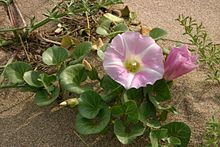
Tribus Convolvuleae: Beach bindweed ( Calystegia soldanella )

Tribe Cardiochlamydeae: Poranopsis paniculata
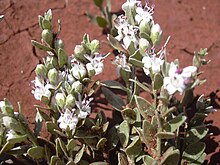
Tribus Cresseae: inflorescences of Cressa truxillensis

Tribus Cuscuteae: nettle silk ( Cuscuta europaea )
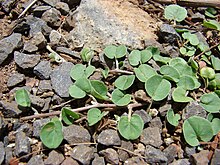
Tribus Dichondreae: Dichondra micrantha

Tribe Ipomoeeae: Ipomoea batatas
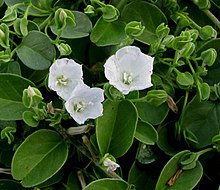
Tribus Jacquemontieae: Jacquemontia sandwicensis

Tribus Merremieae: Distimake aegyptius

Tribus Merremieae: Merremia palmata

Tribus Merremieae: Xenostegia tridentata
Tribus Aniseieae Stefanović & DFAustin : Since 2017 it only contains three genera:
Tribus Cardiochlamydeae Stefanović & DFAustin :
Tribe Convolvuleae (Choisy) Choisy
Tribus Cresseae Benth. & Hook.
For the time being in tribe Cresseae the genera are:
Tribe Cuscuteae Choisy : It contains only one genus:
Tribus Dichondreae (Choisy) Choisy :
The following were temporarily placed in the dichondreae:
Tribe Erycibeae (Endl.) Hall. f.
Tribus Humbertieae Stefanović & DFAustin : It contains only one genus:
Tribus Ipomoeeae Hallier f.
Tribus Jacquemontieae Stefanović & DFAustin : It contains only one genus:
Tribe Maripeae Webb. & Berth. : It contains about nine genera:
Tribus Merremieae (preliminary) DFAustin : It is not monophyletic:
|
Botanical history
Early botanical depictions of bindweed plants can be found, for example, in the New Kreüterbuch (1543) by Leonhart Fuchs ; the plants depicted there are Calystegia sepium and Convolvulus arvensis .
Carl von Linné described in Species Plantarum (1753) and Genera Plantarum (1754) with Convolvulus , Cressa , Cuscuta , Evolulus , Ipomoea and Porana, a total of six genera that are now included in the family. The bindweed family was described by Antoine-Laurent de Jussieu in Genera Plantarum in 1789 .
Over the course of time, there have been a wide variety of views on the infra-family systematics of the bindweed family: the systematics of the bindweed family presented in three publications by Jacques Denys Choisy from 1833 to 1844 and summarized again in 1845 divides them into four tribes, the Argyreieae, the Convolvuleae, the Dichondreae and the Cuscuteae. The genus Erycibe was excluded from the family and run as an independent family Erycibaceae. Other editors, such as August Progel in Flora Brasiliensis, also removed the genus Cuscuta as an independent family Cuscutaceae from the family. George Bentham and Joseph Dalton Hooker, in turn, also classify the Nolana , which today belongs to the nightshade family (Solanaceae), to the bindweed family.
In 1893 Hans Gottfried Hallier presented a further systematic classification of the family, which divided it into Echinoconeae (with prickly pollen grains) and Psiloconeae (with non-prickly pollen grains). He further subdivides these groups into the tribe Cuscuteae, Wilsonieae, Dichondreae, Erycibeae, Poraneae, Dicranostyleae, Convolvuleae, Ipomoeeae and Argyreieae. Many of these tribes were recognized until the 20th century, although the assignment of the genres to these tribes often changed. The latest family system based on traditional methods comes from Daniel Frank Austin from 1973, which he revised again in 1998.
In molecular biological studies, the Echinoconeae Halliers proved to be monophyletic; in the last published systematics of the family of Saša Stefanović, Daniel Frank Austin and Richard Olmstead from 2003, however, some of the tribes are dissolved and reorganized into new tribes.

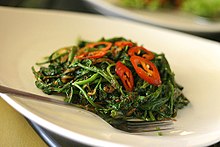

use
The most important food type of the bindweed family is the sweet potato ( Ipomoea batatas ), of whose tuberous thickening of the root around 126 million tons were harvested worldwide in 2007 . It has been collected and eaten in South America for at least 8,000 to 10,000 years ; the oldest evidence of cultivated sweet potatoes is from around 2000 BC. Dated. Furthermore, the water spinach ( Ipomoea aquatica ) is often used as a leaf vegetable. The species is native to Africa, Asia and the Pacific Islands and has been used since around 200 BC. Used in South Asia until 300 AD. In China, other members of the family are rarely used as food, for example Convolvulus chinensis , Ipomoea cairica , Ipomoea mauritiana , Ipomoea staphylina and Merremia hungaiensis as tuber or root vegetables or starch sources and Ipomoea alba and Ipomoea muricata as leaf vegetables.
Some species from the genera Convolvulus , Calystegia and Ipomoea are used as ornamental plants , for example the creeping bindweed ( Convolvulus sabatius ), the three-colored bindweed ( Convolvulus tricolor ), the common bindweed ( Calystegia sepium ), the forest bindweed ( Calystegia silvatica ) Cardinal morning glory ( Ipomoea × multifida ), the sky-blue morning glory ( Ipomoea tricolor ) and the purple morning glory ( Ipomoea purpurea ).
Turbina corymbosa , Ipomoea tricolor and Argyreia nervosa in particular have various ritual and ethnomedical uses. The effectiveness is mostly based on the ergot alkaloids contained, such as lysergic acid amide .
swell
literature
- Saša Stefanović, Daniel F. Austin, Richard Olmstead: Classification of Convolvulaceae: A Phylogenetic Approach. In: Systematic Botany. Volume 28, No. 4, 2003. pp. 791-806 ( PDF file ; 318 kB).
- Daniel F. Austin: Convolvulaceae (Morning Glory Family). 1997 Internet publication , accessed May 25, 2014.
Individual evidence
- ↑ a b c d Eckart Eich: Solanaceae and Convolvulaceae: Secondary Metabolites Biosynthesis, Chemotaxonomy, Biological and Economic Significance (A Handbook). Springer, Berlin / Heidelberg 2008, ISBN 978-3-540-74540-2 , doi: 10.1007 / 978-3-540-74541-9 .
- ↑ Dietrich Frohne, Uwe Jensen: Systematics of the plant kingdom with special consideration of chemical characteristics and plant drugs . 4th edition, Gustav Fischer, Stuttgart / Jena / New York, ISBN 3-437-20486-6 , p. 318.
- ^ Helene A. Martin: The family Convolvulaceae in the Tertiary of Australia: evidence from pollen. In: Australian Journal of Botany. Volume 49, No. 2, 2001, pp. 221-234, doi: 10.1071 / BT00057 .
- ^ Mary E. Cosner, Robert K. Jansen, Thomas G. Lammers: Phylogenetic relationships in the Campanulales based on rbcL sequences. In: Plant Systematics and Evolution. Volume 190, No. 1-2, 1994, pp. 79-94, doi: 10.1007 / BF00937860 .
- ^ A b Saša Stefanović, Daniel F. Austin, Richard Olmstead: Classification of Convolvulaceae: A Phylogenetic Approach. In: Systematic Botany. Volume 28, No. 4, 2003, pp. 791-806 (PDF file; 318 kB) .
- ^ GW Staples: Revision of Asiatic Poraneae (Convolvulaceae) - Cordisepalum, Dinetus, Duperreya, Porana, Poranopsis, and Tridynamia. In: Blumea. Volume 51, 2006, pp. 403-491 ( abstract ).
- ↑ a b Sarah Maria Athie-Souza, George Staples, Carmen Sílvia Zickel, Maria Teresa Buril: Towards a Better Understanding of the Tribe Aniseieae: Revisiting Aniseia and Iseia (Convolvulaceae). : In: Systematic Botany , Volume 42, Issue, 3, 2017, pp. 590–605. doi : 10.1600 / 036364417X696131
- ↑ a b c d e f g h i j k l m n o p q r s t u v w x y z aa ab ac ad ae af ag ah ai aj ak al am an ao ap aq ar as at au av aw ax ay az ba bb bc bd be Rafaël Govaerts (Ed.): Convolvulaceae. In: World Checklist of Selected Plant Families (WCSP) - The Board of Trustees of the Royal Botanic Gardens, Kew . Retrieved November 25, 2018.
- ^ A b David John Mabberley: Mabberley's Plant-Book. A portable dictionary of plants, their classification and uses. 3. Edition. Cambridge University Press, Cambridge u. a. 2008, ISBN 978-0-521-82071-4 .
- ↑ AR Simões, G. Staples: Dissolution of Convolvulaceae tribe Merremieae and a new classification of the constituent genera. In: Botanical Journal of the Linnean Society , Volume 183, 2017, pp. 561-586.
- ↑ Jacques Denys Choisy: Convolvulaceae . In: A. de Candolle (Ed.): Prodromus systematis naturalis regni vegetabilis. Volume 9, Paris, 1845, pp. 323-465 ( digitized version ).
- ↑ August Progel: Cuscutaceae. In: Flora brasiliensis. Volume 7, Munich / Leipzig, 1871, pp. 371-390 ( digitized version ).
- ↑ George Bentham, Joseph Dalton Hooker: Convolvulaceae. In: Genera plantarum: ad exemplaria imprimis in Herberiis Kewensibus servata definita. Volume 2, Part 2, London, 1873, pp. 865-881 ( digitized ).
- ↑ Hans Hallier: Attempt of a natural structure of the Convolvulaceans on a morphological and anatomical basis. In: Botanical yearbooks for systematics, plant history and plant geography. Volume 16, No. 4-5, 1893, pp. 453-591 ( digitized version ).
- ↑ Jennifer A. Woolfe: Sweet Potato: An Untapped Food Resource. Cambridge University Press, Cambridge u. a. 1992, ISBN 0-521-40295-6 , limited preview in Google Book Search.
- ^ Daniel F. Austin: Water Spinach (Ipomoea aquatica, Convolvulaceae) A food gone wild. In: Ethnobotany Research & Applications , Volume 5, 2007, pp. 123-146 ( PDF file ).
- ↑ Shiu-ying Hu: Food Plants of China. The Chinese University Press, Hong Kong, 2005, ISBN 962-201-860-2 .
- ↑ Eckehart J. Jäger, Friedrich Ebel, Peter Hanelt, Gerd K. Müller (eds.): Exkursionsflora von Deutschland . Founded by Werner Rothmaler. tape 5 : Herbaceous ornamental and useful plants . Springer, Spektrum Akademischer Verlag, Berlin / Heidelberg 2008, ISBN 978-3-8274-0918-8 .
Web links
- The Convolvulaceae family on the AP website. (engl.)
- Convolvulaceae Unlimited .